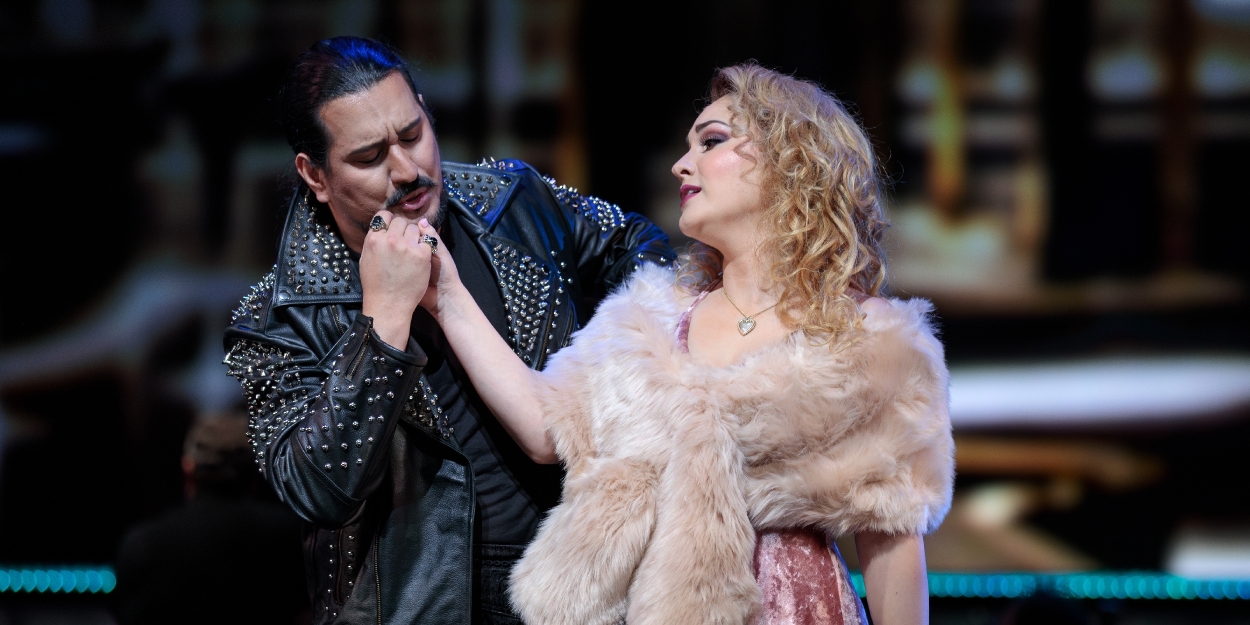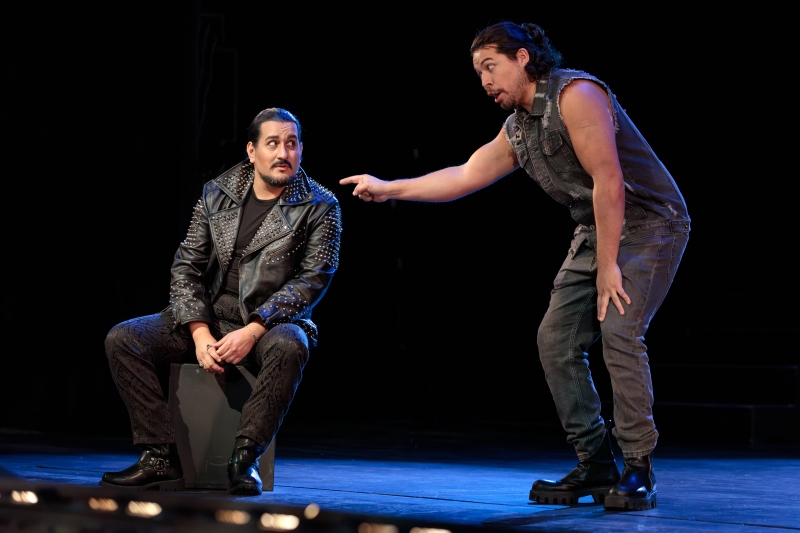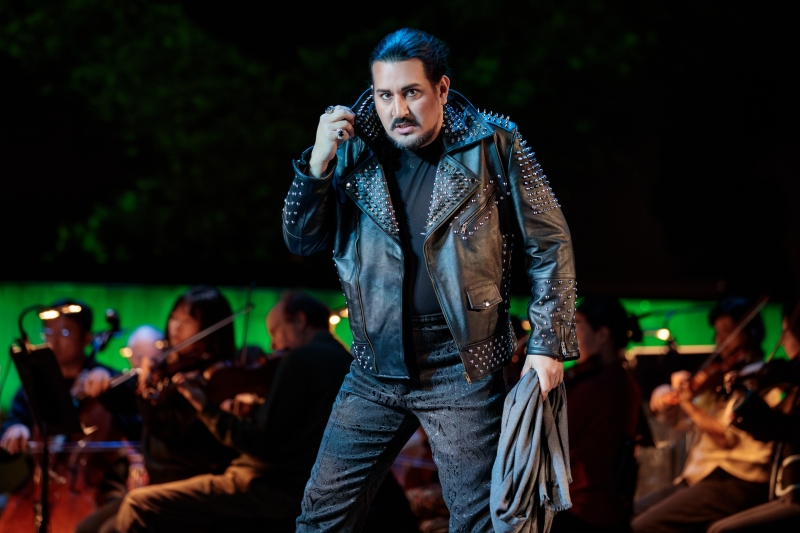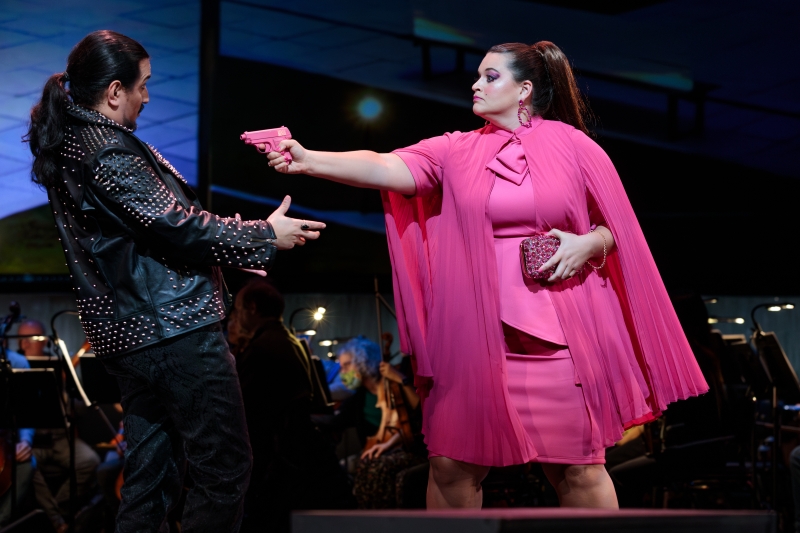Review: San Diego Opera's Production of Mozart's DON GIOVANNI at San Diego Civic Center Theater
The Cleverly Updated Story of a Devilish Rake

San Diego Opera’s most recent production of Mozart’s Don Giovanni is an example of how opera companies hope to attract younger audiences while coping with rising costs and smaller budgets. The pandemic hasn’t been kind to the arts. The National Endowment for the Arts has reported that stage performances joined oil drilling/exploration and air transportation “as the steepest-declining areas of the U.S. economy in 2020.” And opera, which had already been experiencing shrinking audiences, was the hardest hit of all the arts. Smaller companies are struggling to stay in business. Even New York’s Metropolitan Opera had to dip into its reserves this season for $40 Million.
In my interview with Director Kyle Lang, he decried the absence of opera from school curiculums and embarrassingly little government support for the arts. He also believes, “We should cater to people who grew up with video games and iPhones because they take in information differently.”
Dropping the problems of gods and royalty for those of contemporary society is one possibility, and Lang directed San Diego Opera’s production of As One in 2017. Its story revolves around gender change.
Modern costuming and more modest settings are additional ways to update appeal—and reduce costs. San Diego Opera’s latest production of Mozart’s Don Giovanni checks those two boxes. Lang, who directed an excellent full-scale version of Carmen for the company in 2019, said this is the first time he has staged a production without traditional scenery and with the orchestra front and center. The opera’s characters are in modern dress and projections are used to make it clear that the story has been reset in contemporary society.
Mozart and librettist Lorenzo Da Ponte’s Don Giovanni is the story of a womanizer who ultimately pays for his sins. In the “MeToo” world he’d be likely to pay well before the end of the first act. The nobleman’s servant Leporello tells us Giovanni has logged 1003 conquests in Spain and hundreds more in other countries. But Director Lang sees Giovanni as “amoral or immoral.” Not evil, he’s simply unable to control impulses that most of us may have without acting on them.
The curtain opens with a scene in which the Don has just taken advantage of a young girl. Her father pursues Giovanni, challenges him to a duel and is killed. The Don, clearly sex-addicted and totally unrepentant, spends the rest of the opening act, and much of the final second, pursuing new conquests. He orders Leporello to help while also attempting to have him take the blame for what he himself has done.

Giovanni (baritone Germán Enrique Alcántar) and Leporello (baritone Ethan Vincent) combined impressively for most of the production’s action and comedy. Alcántar has a strong voice and is perfect in the role of a charming, incorrigibly devilish rogue.
Leporello provides by far the best comic moments as he complains about his mistreatment while trying to evade those who should instead be hunting Don Giovanni. Setting PC concerns aside for the moment, his “catalog” aria was hilarious and seemed at times to anticipate Gilbert and Sullivan. It also offered the most effective time-setting clue as the back screen showed that the conquest list came from Tinder on his cell phone.
Other imaginative indications of updating included neon color suits for men, colorful contemporary dresses for women, and guns in place of knives. Dialog conflicted with action at one point when Don Giovanni referred to the gun he holds as a knife. Aside from Tinder and an EKG of Zerlina’s rapid heartbeat as Giovanni woos her, background projections were used lightly, most often with stills of contemporary rooms and outdoor settings.
Director Lang wanted to portray Giovanni as a rock star in a leather jacket, but despite a

few sparkles, I felt the vibe was more Hell’s Angels, picturing a last-minute escape from final retribution on a roaring hog.
Soprano Megan Moore as Donna Elvira offered a highlight aria with the poignant “Mi tradi quell'alma ingrata” near the end of Act II. Soprano Ashley Fabian’s Zerlina was entertainingly far from tradition, coy and aggressively flirtatious rather than a naïve victim. And she has a lovely light soprano voice.
Arrogantly confident of invulnerability, reminding me of at least one of today’s politically important figures, the Don succumbs to the graveyard statue of Il Commendatore, the father he killed in the first act. Bass Brent Michael Smith was motionless and white from hair to shoes in the role and sang with eerie ominous effect before Giovanni suddenly fell through a trap door into the red-lit fires of punishment.

Rounding out the cast to good effect were soprano Tasha Koontz as Donna Anna, tenor Alexander McKissick as Don Ottavio, and bass Stefan Egerstrom as Masetto. About 30 San Diego Symphony musicians sat behind the singers, and principal San Diego Opera conductor Yves Abel ensured seamless integration of orchestra and singers. Chorus Master Bruce Stasyna provided a tasteful, decidedly non-contemporary harpsichord continuo during recitatives.
So, is this the way to the future of opera? There were few empty seats, a promising mix of young and old attentive from beginning to end, and they demanded four curtain calls. But—
I’m not convinced this is more than a partial answer if the objective is to appeal to, as Director Lang suggested, those who “grew up with video games and iPhones.” Don Giovanni is three and a half hours long with an intermission. Tik Tok repeats 25-second videos on loops that go viral. iPhone users text with abbreviations and become impatient if there’s no reply in seconds.
The paintings of Old Masters can be restored, but it’s unlikely we will ever see a Mona Lisa restoration that replaces her dark stodgy dress and hair style with a glittering Taylor Swift costume and short blond hair, though it does suggest a great satirical magazine cover.
I agree that every important character in an opera is open to varying interpretations, and Mozart himself might well have enjoyed Lang’s version of Zerlina. But the basic problem with grand opera from his era is that the melodic conventions and vocal styles are foreign to a vast majority of today’s young people because opera and classical music are seldom part of their education and seldom heard on the entertainment sources they frequent (other than in unidentified snippets in video games and TV ads). And as people age, they have a strong bias against music they didn’t know when they were growing up.
I fear opera will continue to struggle as long as the arts are seen as an expendable frivolity rather than an important investment in enriching lives and expanding the understanding of others.

Top Photo is of Enrique Alcántar as Don Giovanni and Ashley Fabian as Zerlina. All photos by Karli Cadel.
Visit San Diego Opera for schedule of furture performances and ticket information.
Reader Reviews

Videos

